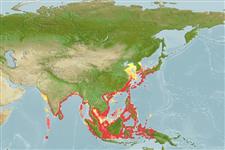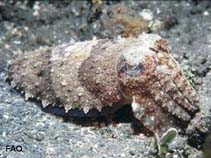Sepia aculeata Van Hasselt, 1835
Needle cuttlefish| Native range | All suitable habitat | Point map | Year 2050 |

|
| This map was computer-generated and has not yet been reviewed. |
| Sepia aculeata AquaMaps Data sources: GBIF OBIS |
Classification / Names প্রচলিত নাম সমূহ | প্রতিনাম সমূহ | CoL | ITIS | WoRMS
Cephalopoda | Sepiida | Sepiidae
Environment: milieu / climate zone / গভীরতার পরিসীমা / distribution range বাস্তুসংস্থান
; গভীরতার পরিসীমা 0 - 60 m (সূত্র 275), usually 5 - 20 m (সূত্র 275). Tropical; 41°N - 6°S, 69°E - 138°E (সূত্র 1695)
Distribution দেশ সমূহ | এফ এ ও এলাকাসমূহ | বাস্তুতন্ত্র | দৃষ্টিগোচর | প্রচলন
Indo-West Pacific: Southern India to Japan and the Philippines.
Length at first maturity / আকৃতি / Weight / Age
পরিপক্কতা : Lm 9.5, range 10 - 12 cm Max length : 23.0 cm ML পুরুষ/ লিঙ্গ অনিধর্ারিত ; (সূত্র 275); সবের্াচ্চ প্রকাশিত ওজন : 1.3 kg (সূত্র 1695)
Short description বহিঃ অঙ্গ সংস্থান
Life cycle and mating behavior পরিপক্কতা | প্রজনন | ডিম ছাড়া | Eggs | ডিম্বধারন ক্ষমতা | Larvae
Main reference
সূত্র সংখ্যা | সমম্বয়কারী | সহযোগী
Jereb, P. and C.F.E. Roper (eds.). 2005. (সূত্র 1695)
IUCN Red List Status
(সূত্র 130435: Version 2024-2)
CITES status (সূত্র 108899)
CMS (সূত্র 116361)
Threat to humans
Human uses
মৎস্য: বাণিজ্যিক
| FishSource |
হাতিয়ার
আরো তথ্য
Max. ages / sizes
Length-weight rel.
Length-length rel.
Length-frequencies
Mass conversion
প্রাচুর্য
ইন্টারনেট সুত্র
BHL | BOLD Systems | CISTI | DiscoverLife | FAO(Publication : search) | Fishipedia | GenBank (genome, nucleotide) | GloBI | Gomexsi | Google Books | Google Scholar | Google | PubMed | জীবন বৃক্ষ | Wikipedia (Go, অনুসন্ধান ) | জুলজিকাল রেকর্ড



